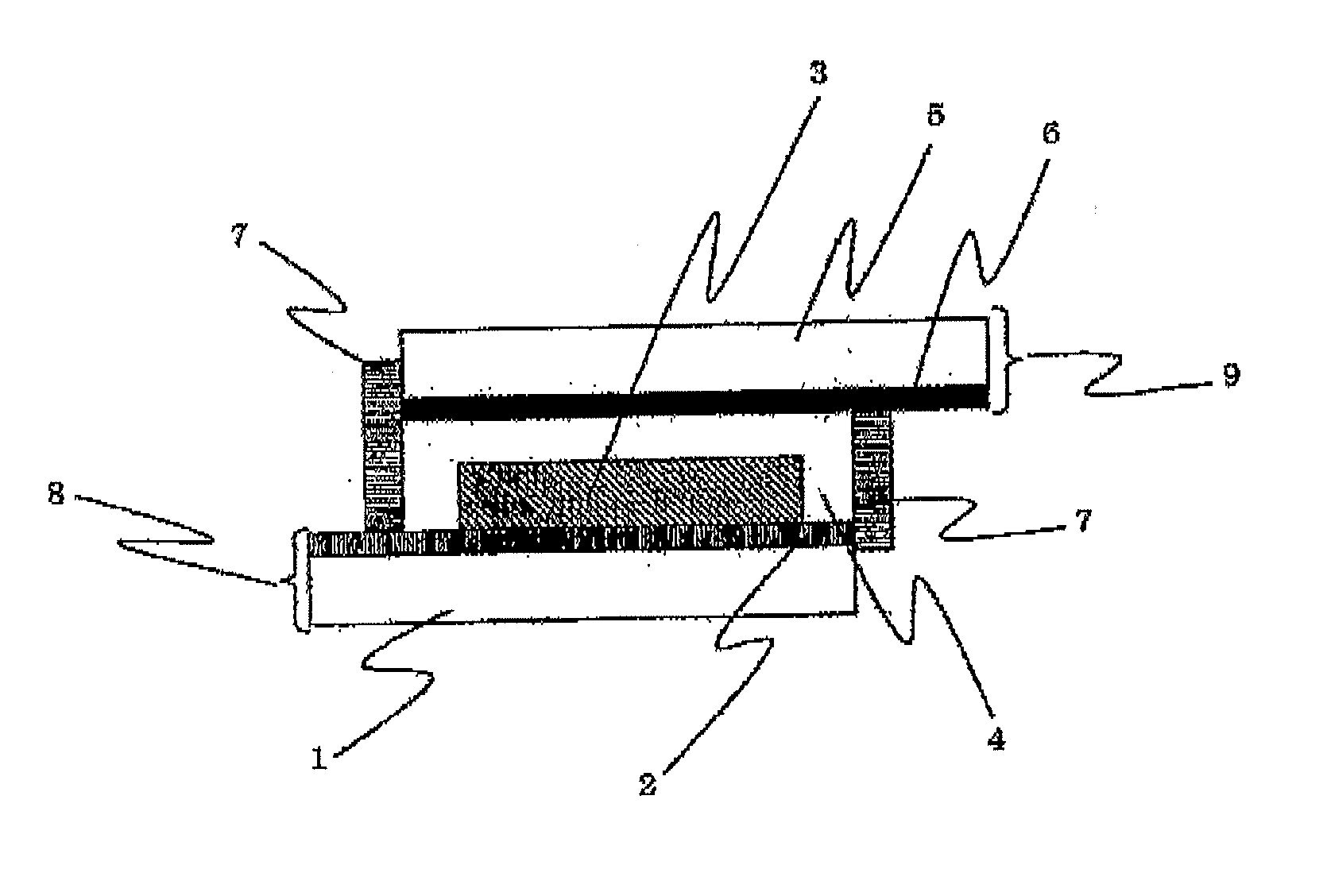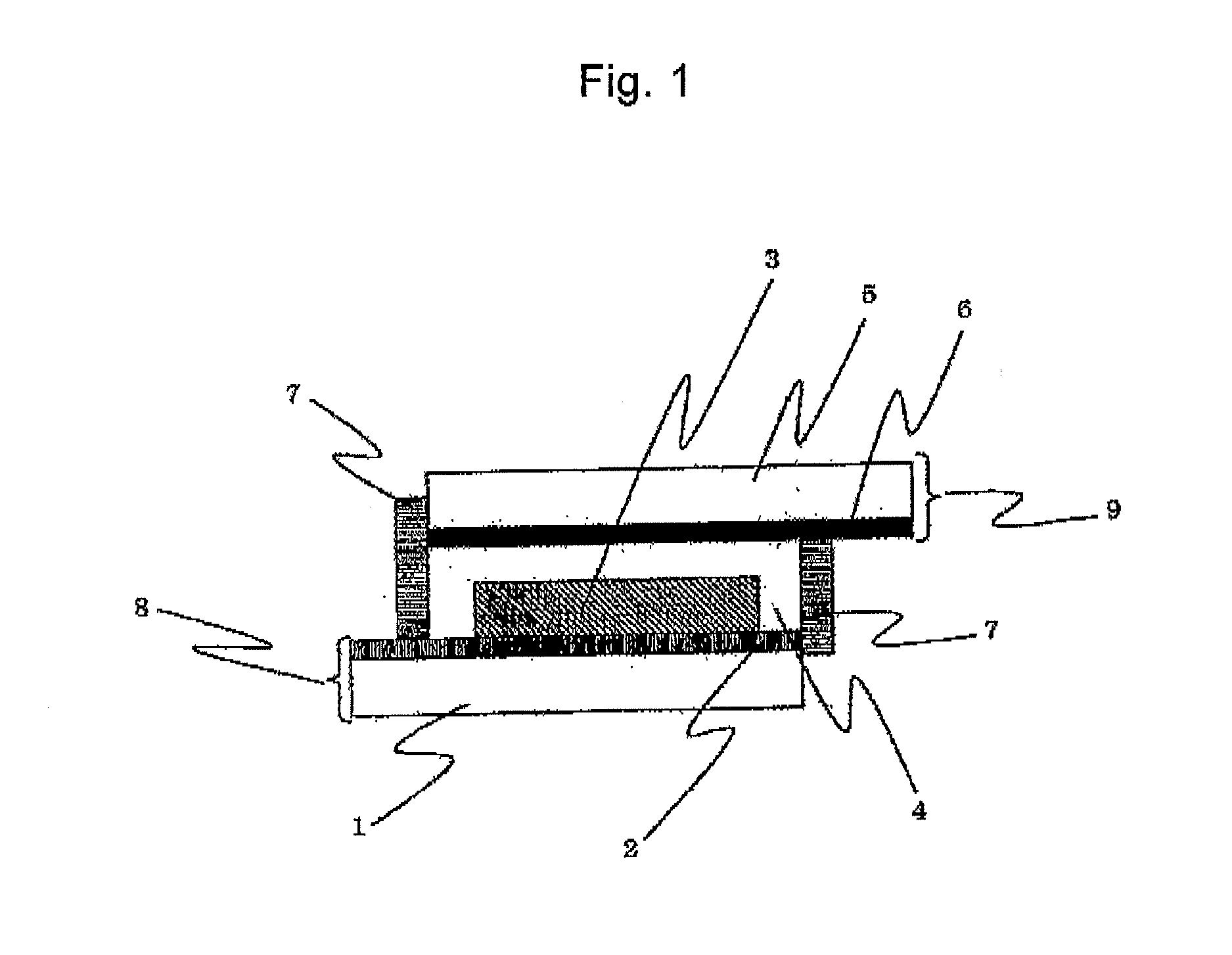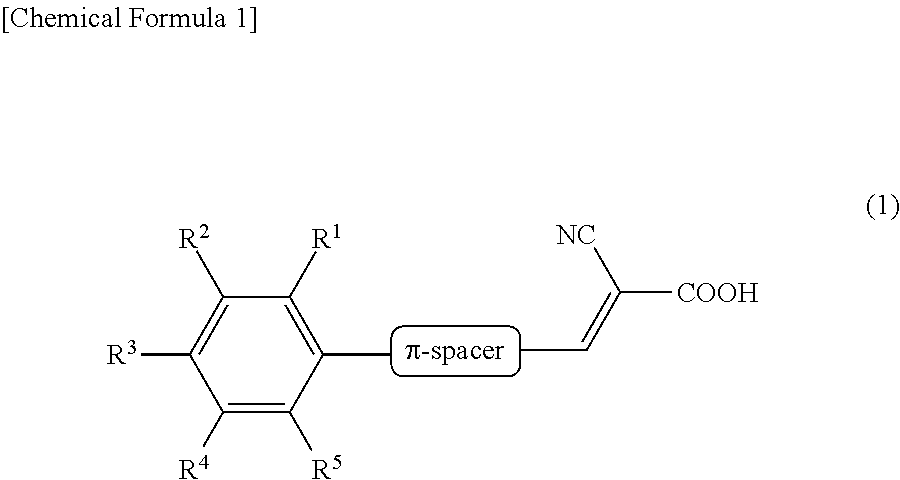Dye-sensitized solar cell and sensitizing dye
a solar cell and dye technology, applied in the direction of metal/polymethine dyes, organic chemistry, electrolytic capacitors, etc., can solve the problems of high production cost and inability to obtain dyes adsorbed as a mixture, and achieve the effect of increasing the energy gap, and increasing the density of dyes adsorbing to the semiconductor surfa
- Summary
- Abstract
- Description
- Claims
- Application Information
AI Technical Summary
Benefits of technology
Problems solved by technology
Method used
Image
Examples
synthesis example 1
Synthesis of sensitizing dyes II-1, II-2, II-3 and II-4
(1) Synthesis of II-1 [2-cyano-3-(5-(2,4-dimethoxyphenyl)thiophen-2-yl)acrylic acid]
[0085]
5-(2,4-Dimethoxyphenyl)thiophene-2-carbaldehyde (1)
[0086]2,4-Dimethoxyphenylboronic acid (972 mg, 5.34 mmol), 5-bromothiophene-2-carboxaldehyde (874 mg, 4.57 mmol), and Pd(PPh3)4 (135 mg) are dissolved in a mixed solvent of toluene and ethanol (80 ml / 40 ml). An aqueous solution (15 ml) of potassium carbonate (2 g) is added thereto, and the reaction mixture liquid is heated to reflux for 24 hours in an argon atmosphere. Water is added thereto, and the mixture is extracted with dichloromethane. The extract is dried over anhydrous sodium sulfate, and then is concentrated under reduced pressure. The residue is purified by silica gel column chromatography (dichloromethane / hexane=2 / 1). Thus, an aldehyde (1) was obtained (1090 mg, 96%).
[0087]1H NMR (600 MHz, CDCl3): δ9.88 (s, 1H), 7.70 (d, J=4.2 Hz, 1H), 7.65 (d, J=8.4 Hz, 1H), 7.49 (d, J=4.2 Hz, ...
synthesis example 2
Synthesis of sensitizing dyes II-5, II-6, II-7, II-8, and II-9
(1) Synthesis of II-5 [2-cyano-3-(5-(4-octyloxyphenyl)thiophen-2-yl)acrylic acid]
[0101]
5-(4-Octyloxyphenyl)thiophene-2-carbaldehyde (3)
[0102]4-Bromophenol (1.0 g, 5.78 mmol), 1-iodooctane (1.67 g, 6.94 mmol), and potassium carbonate (4.0 g, 29 mmol) are dissolved in DMF (40 ml), and the solution is heated to reflux for 24 hours. Water is added to the reaction mixture liquid, and the mixture is extracted with dichloromethane. The extract is dried over anhydrous sodium sulfate, and then is concentrated under reduced pressure. The residue is purified by silica gel column chromatography (dichloromethane / hexane=1 / 1). Thus, bromide (2) (1.48 g) was obtained.
[0103]The bromide (2) (500 mg, 1.75 mmol), 5-formyl-2-thiopheneboronic acid (230 mg, 1.47 mmol) and PdCl2 (dppf) (53 mg) are dissolved in a mixed solvent of toluene and methanol (40 ml / 20 ml), and an aqueous solution (10 ml) of potassium carbonate (1.5 g) is added thereto. T...
synthesis example 3
Synthesis of Sensitizing Dyes II-10 and II-11
(1) Synthesis of II-10 [2-cyano-3-(5-(4-dibutylaminophenyl)thiophen-2-yl)acrylic acid]
[0124]
5-(4-Dibutylaminophenyl)thiophene-2-carbaldehyde (5)
[0125]NBS (4.3 g, 24.3 mmol) is added to a DMF (50 ml) solution of N,N-dibutylaniline (5.0 g, 24.3 mmol), and the mixture is stirred for 1.5 hours at room temperature. Water is added to the reaction solution, and the reaction product is extracted with dichloromethane. The extract is dried over anhydrous sodium sulfate, and then is concentrated under reduced pressure. The residue is purified by silica gel column chromatography (hexane). Thus, bromide (4) (6.17 g) was obtained as an oily matter.
[0126]The bromide (4) (1.5 g, 5.28 mmol), 5-formyl-2-thiopheneboronic acid (0.69 g, 4.4 mmol) and Pd(PPh3)4 (150 mg) are dissolved in a mixed solvent of toluene and ethanol (80 ml / 40 ml), and an aqueous solution (15 ml) of potassium carbonate (2 g) is added thereto. The mixture is heated to reflux for 24 hour...
PUM
 Login to View More
Login to View More Abstract
Description
Claims
Application Information
 Login to View More
Login to View More - R&D
- Intellectual Property
- Life Sciences
- Materials
- Tech Scout
- Unparalleled Data Quality
- Higher Quality Content
- 60% Fewer Hallucinations
Browse by: Latest US Patents, China's latest patents, Technical Efficacy Thesaurus, Application Domain, Technology Topic, Popular Technical Reports.
© 2025 PatSnap. All rights reserved.Legal|Privacy policy|Modern Slavery Act Transparency Statement|Sitemap|About US| Contact US: help@patsnap.com



